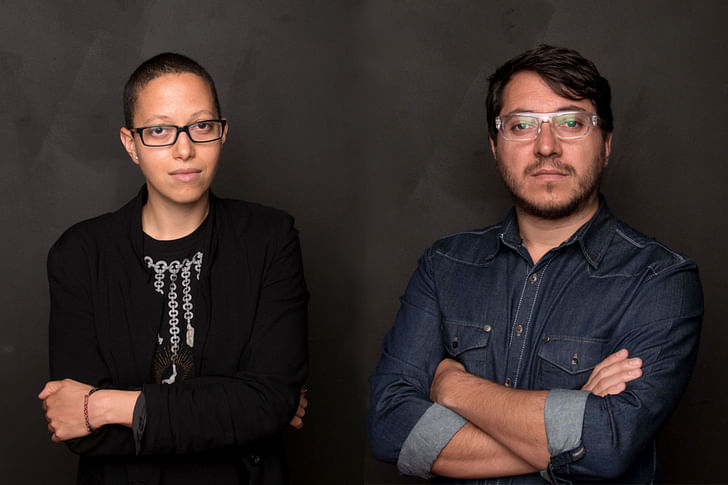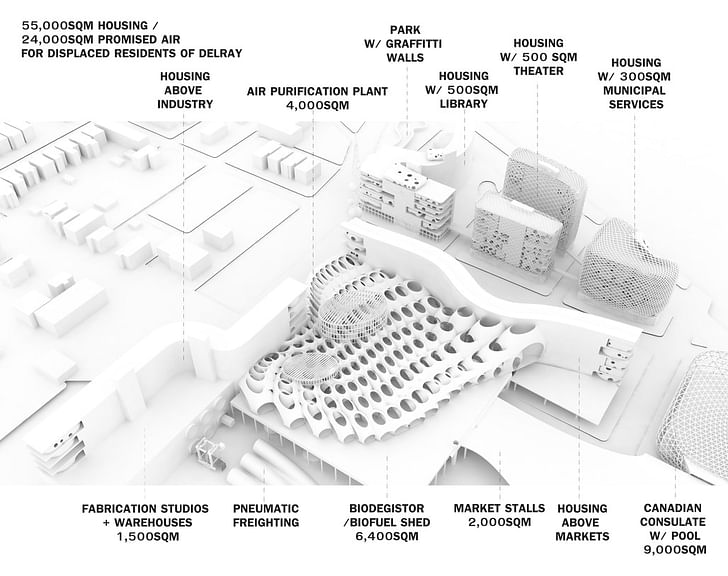

Mitch McEwen and Marcelo López-Dinard, of A(n) Office, explore the intersection of architecture and exhibition, conceiving their New York and Detroit based studio, A(n) Office, as a publication of sorts.
Mitch McEwen has been a long time friend of Archinect—she has one of the most popular blogs on our site and appears as a regular guest on our podcast. Her joint practice with Marcelo López-Dinardi intersects building design, urban design, industrial design, software, spatial research, publications, exhibition design and curatorial projects. The two have collaborated with the Architectural League of New York, the Queens Museum of Art, the Pacific Design Center in Los Angeles, and Detroit’s Imagination Station. Project achievements include publication in Architectural Record, Architect magazine, and ArtNews, as well as awards, including funding from the Graham Foundation, Knight Foundation, and Michigan Economic Development Corporation.
How many people are in your practice?
V. Mitch McEwen: We are currently two active partners, and we each hire on a project basis. A(n) Office is a collaborative studio structure for McEwen Studio and Marcelo López-Dinardi. Right now, there are two designers working a McEwen Studio project in Detroit, and soon there will be two more.
Marcelo López-Dinardi: In the past three years, we have been as few as two and as many as eight.

Why were you originally motivated to start your own practice?
VMM: We had both been doing work in exhibitions and publications—both formats where you collaborate with a number of people extensively for one issue or one temporary exhibit. We wanted to create a way of doing architectural work that operated more like this. We wanted an office that could evolve like a publication, moving from long-distance and loose connections that we associate with digital publication to the in-person day-to-day of a full-time office, as necessary.
MLD: There's also the desire to produce our own projects and channel our interests, choosing only the work that we are interested in doing. Having worked in design firms for others was not an option anymore because we wanted to focus on research as an architectural practice. Teaching, for us, is considered an active practice as well, a space not only to complement the work, but also, to actively engage with the pedagogical space.
What hurdles have you come across?
MLD: Being located in two cities—Detroit and New York—both enhance and complicate our work dynamics. In collaborating there's always the hurdle of agreeing, negotiating, or working productively with difference. Not having a written down agenda doesn't mean we don't have a critical position about the work. We have not one, but two, and this open mode of collaboration has resulted in various forms of interpretations and challenges, all of which are good for clarifying our own agency and how we collaborate.
VMM: In a way, we have been so successful at evading the difficult aspects of a regular office—very little rent, no extensive administration—that it has enabled us to skip over some of the productive pressures of having an office. The downside of this is that we don't have a clear way of articulating what we do. Do we say yes to every project? No. We go after the projects that interest us and align with our agenda, but we haven't been forced to articulate what that is, even to each other. We are committed to democratic urbanism, immigration, the Black diaspora, public resources, and the critical dimension of design.
Is scaling up a goal or would you like to maintain the size of your practice?
VMM: Yes, scaling up in a way that continues the flexibility would be great. Ideally, this would maintain the flatness we have, but with the capacity to do projects that engage a public dimension and work in the range of locations that we map our personal, political, and disciplinary connections to. It would not take a large practice to do this, but large enough to have critical mass for dedicated administrative support and technology.
MLD: Mostly, it would be a way of engaging and collaborating with more people but with the capacity to do projects that engage in a public dimension and work in the range of locations where we find our personal, political, and disciplinary connections. Scaling up also brings the problem of the studio as a dedicated space and having to sustain it, as long as it is open and flexible we can scale up as needed, or stretch-up better than scale up.
What are the benefits of having your own practice? And staying small?
MLD: When connected to an active, pedagogical practice, it allows you to treat your practice with experimentation and openness, since it gives some (economic) freedom to work responding to your own concerns as opposed to a client's or a profit-based enterprise. Staying small becomes an extension of yourself rather than an office apparatus.
VMM: Having our own small practice gives us the flexibility to teach, which is something that is important to both of us. The small size also makes it possible to treat an intellectual exercise like an exhibition as equally significant as full scale construction. We do both with the hope that they reverberate off each other and, so far, that has been the case.
4 Comments
Im always a little surprised that all interviewees always answer "yes" to the "scaling up" question. For a firm attempting to become a traditional architecture firm it is expected, but for firms like this, It seems that scaling up will almost always equate to comprimising the firms mission/philosophy. There is this misconception that large scale projects are more important. Imo, it is the opposite.
I particularly appreciated Matter Design's (Brandon Clifford and Wes McGee) answer, if only for it's historical corrective. "By the way, large firms are a relatively new experiment in architecture. Robert Gutman has a great analysis of architect’s obsessions with studio size. He outlines that for centuries, architecture practices were never larger than roughly 10 people (a studio), until the early 1900s. Now we conglomerate firms of thousands…"
Though perhaps you are talking scale, as in more, "of work", not # of employees.
Many respondents, including A(N) Office, also emphasize "flexibility", as a mode of practice...
Block this user
Are you sure you want to block this user and hide all related comments throughout the site?
Archinect
This is your first comment on Archinect. Your comment will be visible once approved.